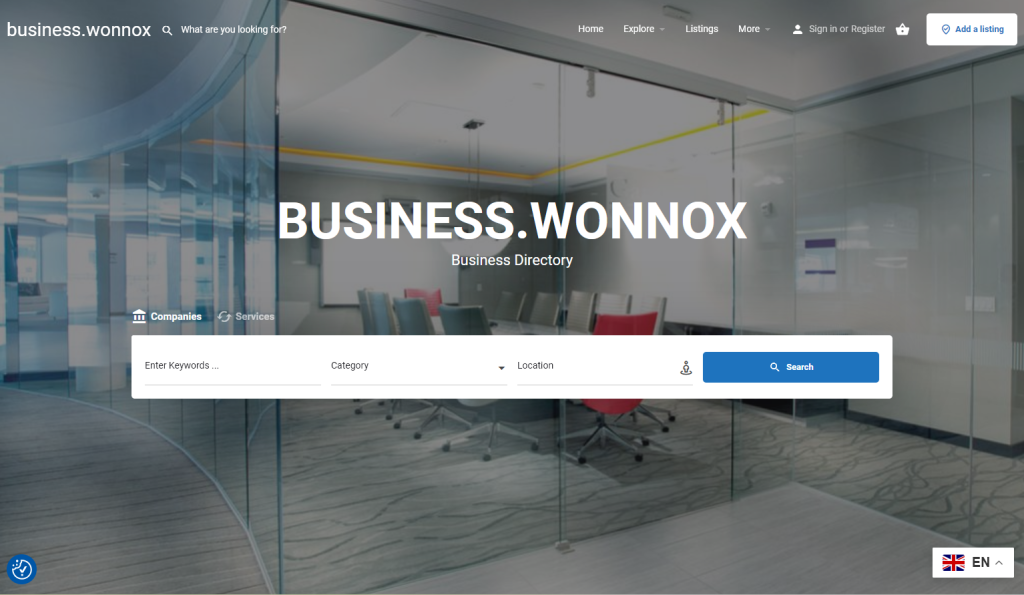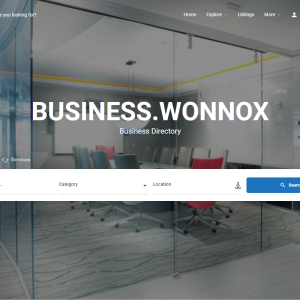
- Direct message
- Leave a review
- Bookmark
- Share
- Report
- prev
- next
Details
-
Wontox Portal
Description
A service listing or profile in a web directory within the business category serves as a detailed, informative summary of a service provider’s offerings, capabilities, and value proposition. Such profiles are designed to attract potential clients, partners, and investors by showcasing the unique aspects of the services provided, making it easier for businesses to be discovered in competitive marketplaces. A well-crafted service listing should be thorough yet concise, containing information that addresses potential customers' needs and builds trust. Here is a breakdown of the key features that make up an effective service listing or profile in a web directory:
1. Service Overview:
Service Name: The name of the service is prominently displayed, making it clear to users what the listing is about.
Service Tagline: A brief, catchy slogan that highlights the core benefit or key feature of the service. This helps capture attention and gives an immediate sense of what the service offers.
About the Service: This section provides a general description of the service, including its purpose, the problems it solves, and the target market. It can outline the value proposition and why this service is necessary for potential clients.
Establishment Details: For service providers, it may be relevant to include when the service was launched, showing experience and stability in the market.
2. Contact Information:
Service Provider’s Name: The name of the business offering the service helps establish brand identity.
Address: Including the physical location or headquarters can build credibility and help clients know where the service is based.
Phone Number and Email: Direct contact details enable potential customers to reach out for more information or to make inquiries.
Website URL: A clickable link to the service provider’s website encourages users to explore the service in more detail.
Social Media Links: Links to social media profiles allow for better engagement and provide additional platforms where users can learn more about the service.
3. Service Description:
Detailed Service Description: This part of the listing provides an in-depth explanation of what the service entails. It should include:The key features and components of the service.
The benefits of using the service.
How the service works (step-by-step if relevant).
Use Cases: Highlighting specific scenarios where the service can be applied helps potential clients understand how the service can meet their needs. For instance, a financial consulting service may detail how it helps businesses optimize cash flow and reduce tax liabilities.
4. Target Market:
Industry Focus: If the service caters to specific industries (e.g., retail, manufacturing, healthcare), this should be clearly mentioned. It helps narrow down the potential clients and makes it easier for businesses to find services tailored to their industry.
Geographic Focus: This indicates where the service is available, whether it’s local, regional, national, or global. It can also specify if the service is provided in multiple languages.
Client Type: Identifying whether the service is suitable for small businesses, startups, or large enterprises helps potential clients determine if the service is right for them.
5. Service Features and Benefits:
Key Features: A bullet-point list of the primary features of the service helps users quickly understand what is included. This could include things like 24/7 support, customizable options, or specialized expertise.
Benefits: This part focuses on what the service can do for the client. It should answer questions like:How does the service add value to a client’s business?
What problems does it solve?
How does it improve efficiency, reduce costs, or drive revenue?
6. Pricing Information:
Pricing Structure: Information about how the service is priced can be critical for potential clients. This may include:Fixed price packages.
Hourly rates.
Subscription or retainer options.
Discounts or Promotions: Any special offers, discounts for first-time customers, or package deals can be mentioned here to attract interest.
Free Consultation or Trial: Offering a free consultation, trial, or demo is a great way to encourage clients to try the service without immediate commitment.
7. Service Delivery Methods:
Mode of Service Delivery: This section explains how the service is delivered to clients. It could be:Online Services: Virtual consultations, remote support, SaaS (Software as a Service) platforms.
On-site Services: Services that require physical presence at the client’s location.
Hybrid Services: A combination of online and on-site service delivery.
Service Availability: It’s also helpful to include information about the service’s availability, such as business hours or whether support is available 24/7.
8. Certifications and Accreditations:
Certifications: Displaying certifications relevant to the service industry (e.g., ISO certifications, ITIL, PMP) adds credibility and demonstrates expertise.
Industry Accreditations: Recognitions from industry bodies or professional associations can also help differentiate the service from competitors.
Compliance Information: If the service adheres to specific legal or industry standards (e.g., GDPR compliance for data protection), it should be highlighted to assure clients of reliability and compliance.
9. Client Testimonials and Reviews:
Testimonials: Featuring feedback from past clients can provide social proof and build trust. Testimonials should highlight how the service has delivered results or solved specific challenges for clients.
Ratings and Reviews: If the directory allows ratings or reviews, it’s important to showcase positive reviews. High ratings can greatly influence potential clients’ decisions.
Case Studies: Brief case studies or success stories can illustrate how the service has benefited other clients, making it easier for new customers to see its practical value.
10. Portfolio or Sample Work:
Examples of Past Projects: Showcasing a portfolio of previous work can help potential clients see the quality and scope of the services offered.
Notable Clients: If the service provider has worked with well-known clients, featuring their logos or mentioning their names (with permission) can boost credibility.
11. Call to Action (CTA):
Direct Engagement: A strong CTA encourages users to take the next step, whether it’s booking a consultation, requesting a quote, or visiting the service provider’s website.
Examples of Effective CTAs: "Schedule a Free Consultation Today," "Get Your Free Quote Now," or "Start Your Free Trial."
12. SEO and Keyword Optimization:
Keyword Integration: A service listing should be optimized with relevant keywords to ensure it ranks well in the directory’s search results. Keywords should naturally appear in the description, features, and service name.
Meta Descriptions: A concise meta description that summarizes the service can help improve click-through rates from search results.
Tags and Categories: Selecting appropriate tags and categories helps place the listing in the right context, making it easier for users to find.
13. Visual Elements:
Service Images: Including relevant images (e.g., screenshots of software, photos of physical products, or service process diagrams) can make the listing more engaging.
Videos: A short video introduction or demonstration of the service can provide a more dynamic overview and help potential clients understand the service better.
Infographics: Using infographics to explain processes or highlight key statistics can make complex information more accessible and appealing.
14. Additional Information:
FAQs: A section addressing common questions helps clarify doubts and provides quick answers to potential clients.
Blog or Resources Link: If the service provider maintains a blog or offers educational resources related to the service, linking to these can demonstrate expertise and provide added value to users.
Guarantees or Refund Policies: Offering guarantees, such as "Satisfaction Guaranteed" or "30-Day Money-Back Guarantee," can help reduce the perceived risk for clients.
15. Sustainability and Corporate Social Responsibility (CSR):
Environmental Practices: Highlighting sustainable practices (e.g., paperless operations, eco-friendly products) can appeal to clients who prioritize working with socially responsible businesses.
Community Engagement: Mentioning any involvement in community activities or charitable initiatives can help build a positive brand image.
These features collectively ensure that a service listing is informative, engaging, and easy to navigate for potential clients. A well-structured service profile in a web directory serves as a digital storefront, making a compelling case for why a business should choose this particular service over others. By combining detailed descriptions, client testimonials, visual elements, and strategic CTAs, service providers can significantly enhance their visibility and appeal in the business category of a web directory.

Add a review